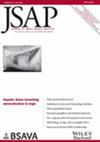Clinical characteristics, treatment, and outcomes of hypoadrenocorticism in dogs
Abstract
Objectives
To determine the long-term survival of dogs with hypoadrenocorticism during the period that desoxycorticosterone pivalate has become widely used. Secondary goals were to compare age at diagnosis, median survival times, and age at death for dogs with hyponatraemic and/or hyperkalaemic hypoadrenocorticism and eunatraemic eukalaemic hypoadrenocorticism, and to determine the frequency of glucocorticoid-related side effects in these dogs.
Materials and Methods
Retrospective cohort study with data collected from medical records and from a questionnaire sent to owners of affected dogs.
Results
141 cases were identified; 125 had spontaneous hypoadrenocorticism and 16 had iatrogenic hypoadrenocorticism secondary to treatment of hyperadrenocorticism. Dogs with spontaneous hyponatraemic and/or hyperkalaemic hypoadrenocorticism were significantly younger at the time of diagnosis (median age: 5.1, range: 0.8 to 14.1 years, n = 97) compared to dogs with spontaneous eunatraemic eukalaemic hypoadrenocorticism (median age: 8.3, range: 3.0 to 12.7 years, n = 26). Sixty-six dogs were included in the survival analysis. For dogs with spontaneous hyponatraemic and/or hyperkalaemic hypoadrenocorticism, all of which were managed with desoxycorticosterone pivalate, median survival time was 5.7 years (95% CI: 4.0 to 7.2 years; n = 47) and median age at death was 11.0 years (range: 4.0 to 17.0 years; n = 30). For dogs with spontaneous eunatraemic eukalaemic hypoadrenocorticism, median survival time was 5.6 years (95% CI: 4.1-N/A years; n = 9) and median age at death was 11.8 years (range: 11.0 to 13.0 years; n = 4). The majority of owners that completed the questionnaire reported side effects commonly associated with glucocorticoid therapy.
Clinical Significance
Hypoadrenocorticism carries an excellent prognosis. Desoxycorticosterone pivalate was the most frequently used mineralocorticoid therapy in this group of dogs.


 求助内容:
求助内容: 应助结果提醒方式:
应助结果提醒方式:


